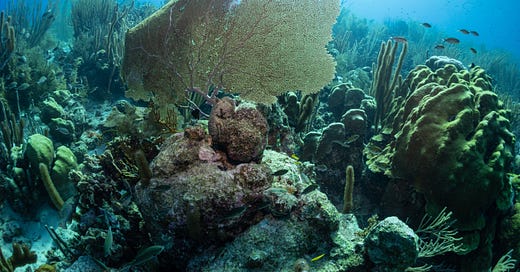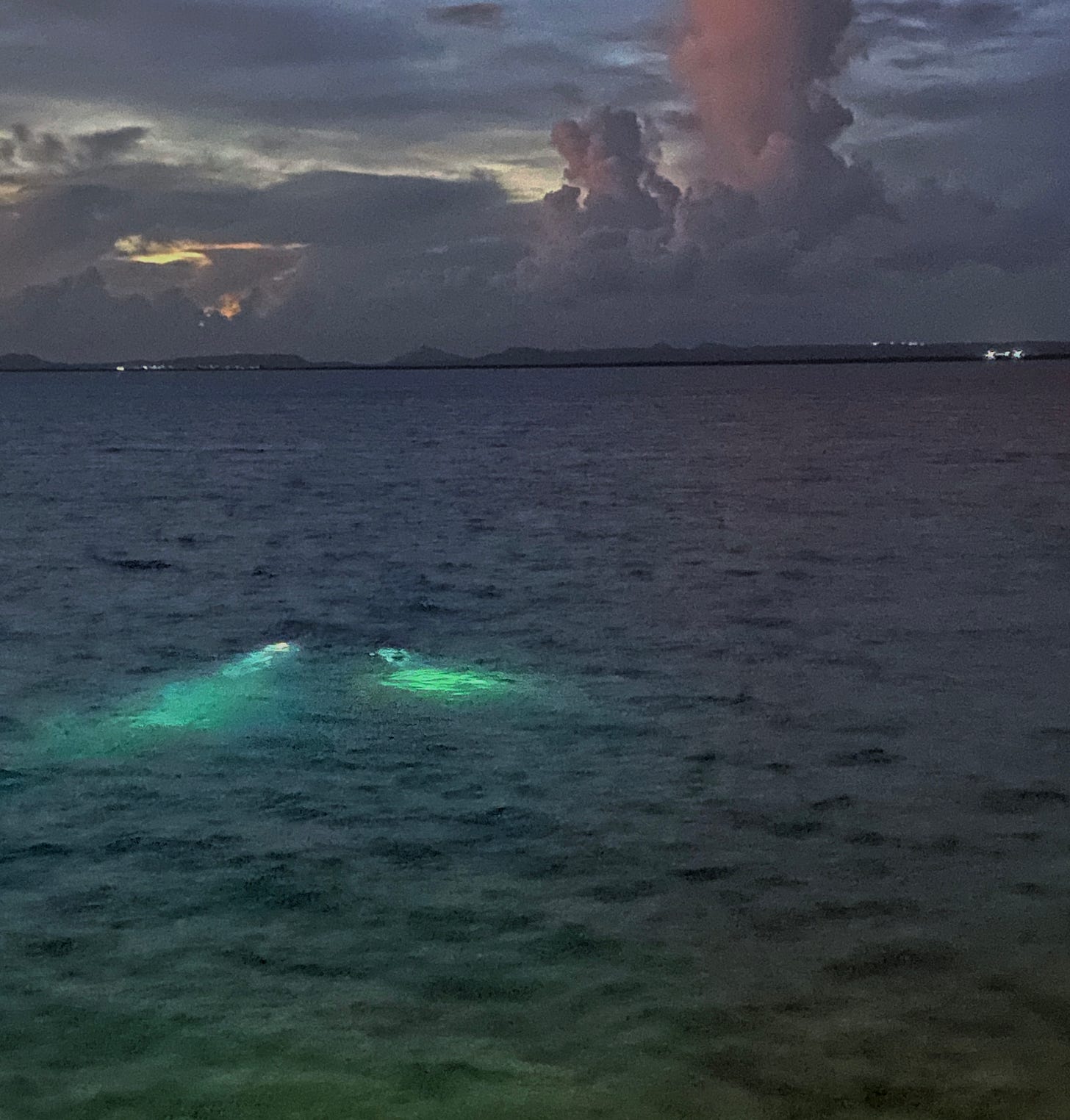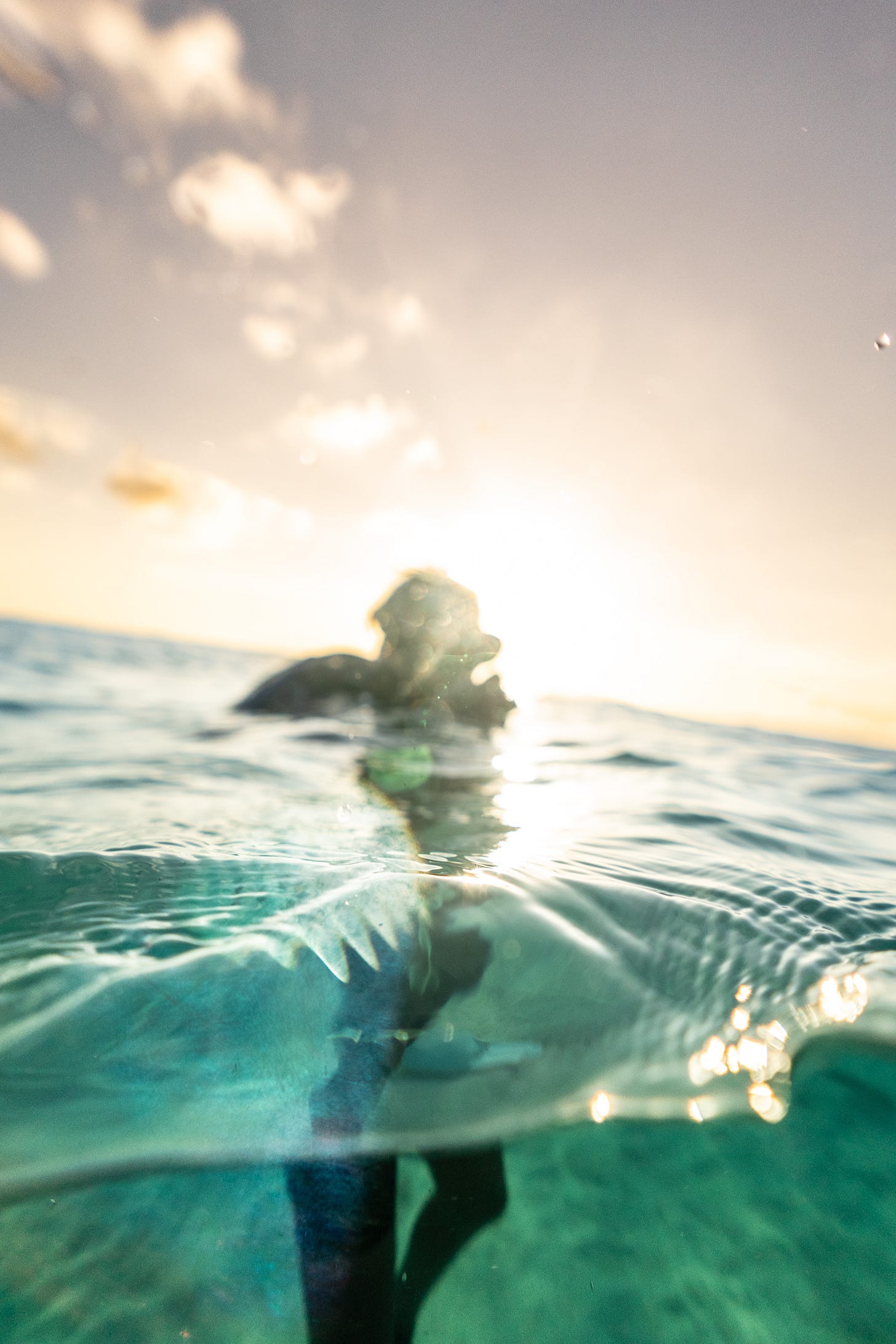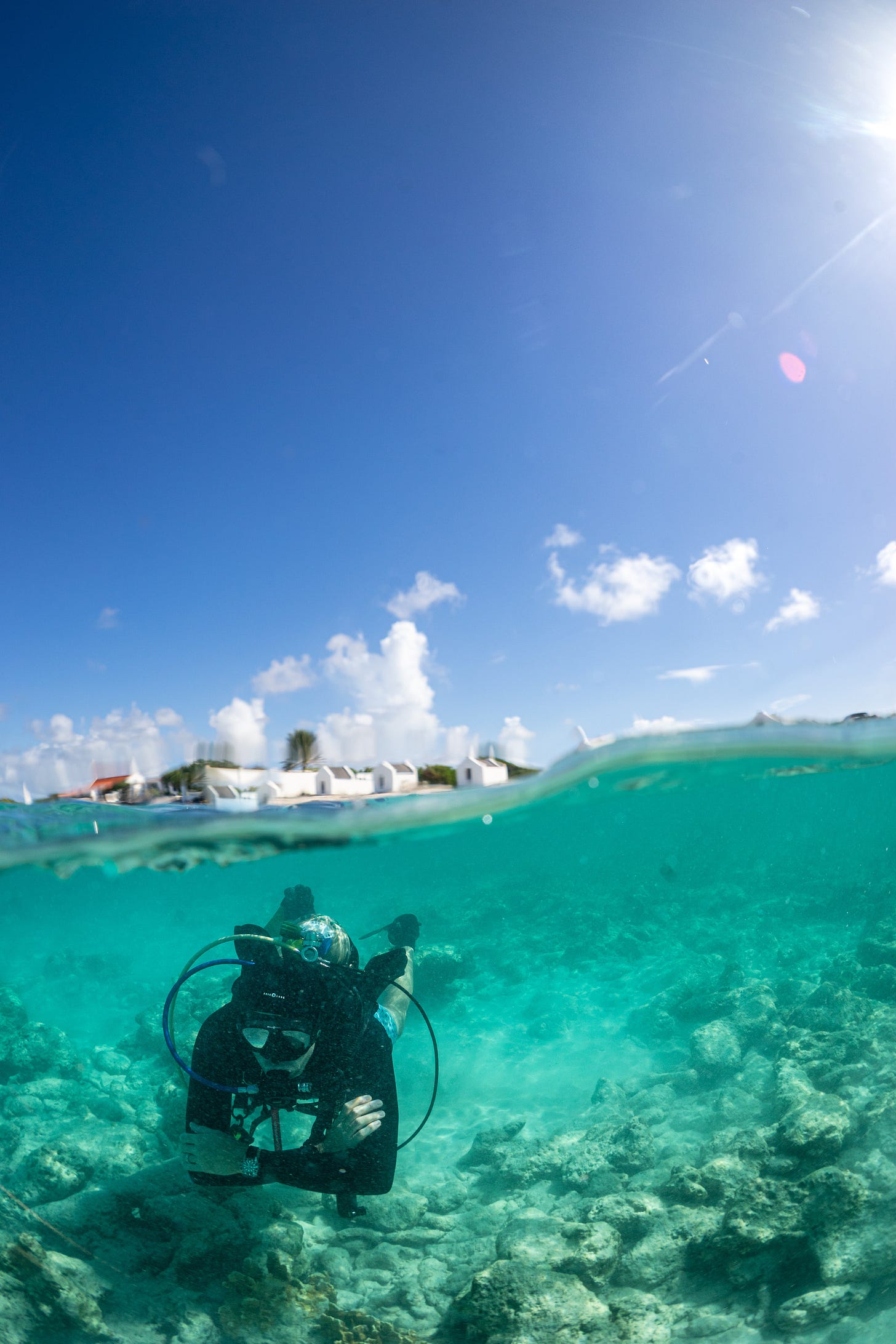A low pressure area located over the far southeastern Caribbean Sea is moving west towards the Windward Islands and is showing an 80% chance of development into a cyclone over the next 48 hours. The low pressure area is expected to pass the island on Thursday afternoon and evening, causing enhanced shower activity and gusty winds. —Royal Netherlands Meteorological Institute Marine Forecast
As I write this, waves are pounding the sea wall below our rental apartment, occasionally sending spray up and over the railing, soaking my previously drying wetsuit. I burned more calories this morning on my ocean swim, through a stiff chop, with every other breath resulting in a mouthful of saltwater. We emerged from our first dive today to a spattering of rain. The weather is definitely changing here.
Bonaire is a reliably calm place to dive, year round. It sits well below “Hurricane Alley,” that band of the Caribbean that gets the brunt of fierce tropical storms, and most dive sites are on the western, leeward coast of the island. I can count on one hand the number of full days it has rained in a decade of coming here, and we’ve never been blown out of a dive day by high seas or wind. We’ll see how the next day or two goes. The sky is slate gray and the wind is threatening to toss our flapping laundry out to sea. Hourly bands of heavy downpours blow through, followed by rainbows.
We’ve had a string of hot days since arriving on Saturday, the kind where the sky itself seems blindingly white and the wind desiccates you. We live like the iguanas that come begging on the balcony, lying languidly in the shade during the day, moving as little as possible. The only relief comes with submersion or, artificially, from air conditioning, which the main living space at this apartment lacks. After a year of ice diving and a few Great Lakes wrecks, it feels utterly decadent, but well earned, to tiptoe over the rocks into the sea, diving in only a pair of trunks and a one-millimeter wetsuit jacket. The water is warm too—85, I even saw 87 degrees Fahrenheit—so warm that there is a heightened alert level for rapid coral bleaching. Even at those bathwater temps, being enveloped in it for an hour cools the body core so that for hours afterwards we’re comfortable.
It’s not just the weather that’s changed on Bonaire. Just since last August when we were here last, new sleek apartments and modernist houses have sprung up like flowers in the desert after a rainfall. The roads feel narrower and more crowded, and we can hear a thumping pulse of bass from somewhere down the shore every night, perhaps from a new nightclub. I’m not ready to say Bonaire has lost its charm yet, but it is evolving and it will be interesting to see how the island manages its rapid development and booming popularity. It used to be the secret haunt of scruffy divers, but now a cruise ship regularly towers over the small downtown of Kralendijk like an iceberg that’s broken loose from someplace far away.
In our earliest years coming to Bonaire, we used to pack the days with diving—padding our logbooks with four, sometimes five, dives a day. Now we’re content with two dives a day, maybe three if we’re particularly energetic. Diving, especially from shore, is hard work, especially in the hot sun. Setting up the tanks, shouldering the heavy kit, then the precarious hike into the surf over ankle snapping coral and prickly urchins, then a long surface swim out to the reef. It’s not that we’re lazy or any less fit than we used to be. We’ve just come to appreciate more than just the diving. The tropical lifestyle is seductive, the way the day falls into a natural rhythm that follows the sun and heat and ways to escape it while still enjoying it. We spend our surface intervals between dives downloading photos from the underwater camera, sipping on a Polar lager in the shade, and napping. There are also the simple routines of grocery runs to the remarkably well stocked supermarket, and trips to the dive shop to swap dead soldiers for full tanks. And inevitably, gear breaks that requires repair, feet get blisters, skin gets sunburnt, Substack missives must be written, and the occasional cockroach needs to be dispatched. We sleep at 9 and rise at 5:30, go for a swim, have coffee and a bowl of muesli, then plan the day, a decidedly simple chore that amounts to choosing a dive site and, later, what’s for dinner.
We’ve done two night dives already, both right off the back stairs of our apartment complex. Close the equator, the sun drops like a stone, with a very short dusk. So if we depart just before sunset (6:20pm), by the time we get to the reef, it’s in deep shadow, then totally dark within 20 minutes. The reef is about 150 meters offshore, due west, and we slowly paddle out on the surface to conserve our tanks’ air, then descend and switch on our underwater torches. It’s been pretty quiet both times, save for a giant hunting tarpon that shadowed us, looking for easy pickings in the blinding beams of our lights. The usual prizes of night dives—octopus, lobster, squid, and eels—have so far played hide and seek. We’ll go looking for them again soon. Our neighbors, a German couple, have spotted two nurse sharks close by, so now we have an additional mission.
While outwardly this may seem like a vacation, in actuality, we are here for a few photo and writing projects. Predictably these involve watches: a pair of new Citizen dive watches, a Swiss watch that will be launched later this year (I’m told), and, as I mentioned last week, the Apple Watch Ultra. The latter has garnered a great deal of interest from readers, listeners of The Grey NATO, and followers of my Instagram account. I’ve been wearing it off and on for morning runs, open water swims, and a few dives. I’ve managed to form a few opinions about it, on which I expounded on this week’s episode of TGN, but I’m waiting to fully weigh in until I’m back home, after I’ve put some more miles and fathoms on it. The short take is: it’s a beautifully designed and remarkably capable device, but I’m not yet convinced it is for someone like me, who would never desire, or require, its 24/7 connectedness or features. I’m still a “tool watch” user at heart—ride it hard, put it away wet—and the Apple Watch demands more care and feeding than that. It would be a brilliant daily driver, so long as you keep a charging cable handy. As a dive computer, the verdict is still out until the Oceanic+ app becomes available. For now, it’s a bright, clear and accurate depth gauge and bottom timer but I’m sticking with my Garmin Descent for tracking my nitrogen tissue loading and underwater navigation.
I’ve been rotating through a few other watches here as well—the Scurfa M.S. 21, the Citizen “Fujitsubo” Challenge Diver, a JP2007 full lume dial Aqualand, and a Zodiac Super Sea Wolf (not to mention the player to be named later). Unlike with a dive computer, there’s not as much to say about an analog watch as a diver really. All of the watches have been legible, with adequate bezel grip and good lume (the Aqualand was spectacular on a night dive). None have leaked. It’s funny how I agonize and strategize back home on what to bring in my watch roll, but then it all fades into the background once I’m here. On a dive I rarely consult my watch except to set the bezel upon descent and the only reason to really check the time topside is to make sure we make it to the dive shop before it closes . I think the larger picture with a dive watch’s appeal for me has evolved in the same way the appeal of Bonaire has changed over a decade of coming here. It’s less strictly about what happens underwater than it is a general tropical, adventuresome vibe, and one that’s easy to live with, doesn’t take itself too seriously, and not too demanding.
The little Citizen felt a bit lightweight back home, but here in the heat, in and out of the sea, the “barely there” titanium and supple strap make it feel right at home. It looks the part, requires no special care besides a quick rinse, and moves from dive timer to beer o’clock effortlessly. The Scurfa is much the same and, pound for pound (British sterling, that is), is still one of the most satisfying watches you can own. Perhaps it’s the Citizen’s and Scurfa’s shared lack of pretension and classic good looks that work so well here. The Zodiac feels like a more serious watch, and it is. Heavy steel, with a kilometer of water resistance, a spring loaded push-to-turn bezel, and a chronometer grade automatic inside, it’s more Special Forces than reefcomber. It catches the dappled light underwater beautifully too. And the Aqualand? It’s fast becoming the “watch of 2022” for me and if I had to choose one watch to have along on a dive trip, this would be it. It’s fun, tough, functional, and about as emblematic of a diving lifestyle as anything short of wearing a copper diving helmet to the beach bar, but more practical.
There’s a lull in the weather now, conveniently coinciding with my last paragraph here. When I shut my laptop I’ll jump in our rental pickup and drive over to the dive shop to collect a couple more tanks of nitrox and we’ll go find a patch of reef to explore. Maybe we’ll even find that nurse shark. But we’d better do it quickly, before the next squall blows through and we have to batten down the hatches. Welcome to the tropics.









Loved this one. The quiet life of a remote dive watch reviewer. I second the Aqualand as one of the best of the year, too.
This has me feeling all kinds of feelings. I had to go back and dig up all of the pictures from our honeymoon there 5 years ago. What a wonderful place. And I am excited about this mysterious new dive watch! Enjoy the trip!